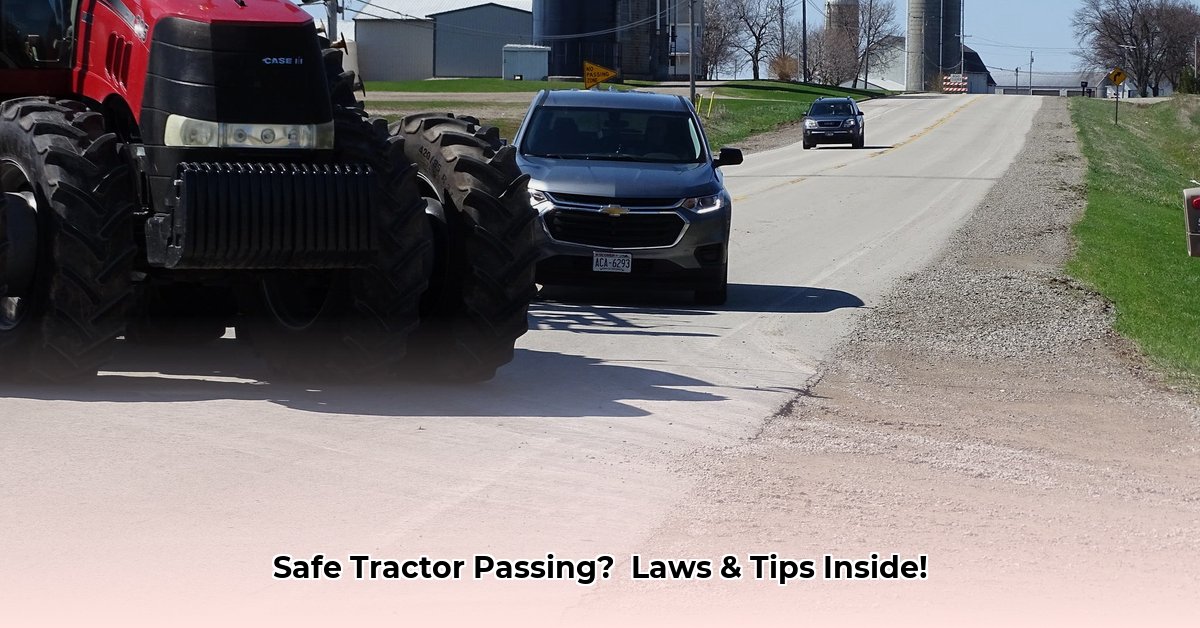
Sharing the road with tractors and other agricultural vehicles requires extra caution. This comprehensive guide provides essential information on safe passing techniques, state regulations, and crucial safety considerations for drivers and farmers alike.
Understanding the Challenges of Passing Farm Machinery
Large, slow-moving farm equipment presents unique challenges to other drivers. Their size can obstruct visibility, and their reduced speed creates significant differences in traffic flow. Successfully and safely passing a tractor demands careful planning and awareness.
State-Specific Regulations: A Patchwork of Laws
State laws governing the operation of farm vehicles vary considerably. Regulations concerning lighting, reflectors, and weight limits differ significantly across jurisdictions. This inconsistency contributes to confusion and potential safety hazards. Before driving in unfamiliar areas, familiarize yourself with the local regulations.
The "Three-Car Rule": Prioritizing Safety
The "three-car rule" is a practical safety guideline. If you see a tractor with one or more vehicles already attempting to pass, wait your turn. Providing ample space during passing maneuvers significantly reduces the risk of accidents. This simple rule can be life-saving.
Visibility: A Critical Factor in Safe Passing
Poor visibility significantly increases the risk when passing farm machinery. Agricultural vehicles often have less powerful lights than cars making them harder to see at night or in inclement weather. Always maintain a greater-than-usual following distance, especially in low-light conditions or adverse weather. Did you know that poor visibility accounts for a substantial portion of accidents involving farm machinery?
How to Pass a Tractor Safely: A Step-by-Step Guide
Passing a tractor safely requires careful planning and execution. Follow these steps:
- Assess the Situation: Check for oncoming traffic, road conditions (wetness, potholes), and visibility before attempting to pass.
- Signal Your Intentions: Use your turn signal to alert the tractor operator and other drivers of your intention to overtake. Clear signaling is crucial for preventing accidents.
- Check Your Mirrors: Before initiating the pass, quickly glance in your mirrors to ensure the road is clear behind and beside you.
- Overtake Safely: Pass decisively while maintaining a safe distance. Avoid attempting to squeeze past too closely.
- Return to Your Lane: Once you've cleared the tractor, signal your intention to merge back into your lane and do so safely.
When Passing Isn't an Option
In situations with heavy traffic, at night, or during inclement weather, passing a tractor may be unsafe. Prioritize safety and wait until conditions improve before attempting to overtake. Patience is paramount.
The Importance of the SMV Emblem
The bright orange triangular Slow-Moving Vehicle (SMV) emblem is a critical safety indicator. When you see this emblem, exercise extreme caution, provide ample space, and reduce your speed. This simple warning sign is vital for preventing collisions.
Shared Responsibility: A Collaborative Approach
Road safety is a shared responsibility. Tractor operators should maintain their equipment in good condition, ensuring proper lighting and markings, including the SMV emblem. They should also be aware of traffic flow and pull over when safe, especially on roads with limited passing opportunities.
Improving Farm Equipment Road Safety Regulations: A Multifaceted Approach
Addressing farm equipment road safety requires a concerted effort. Inconsistent state regulations create challenges for both farmers and drivers. Standardizing regulations across states is crucial.
Key Areas for Improvement:
- Enhanced Visibility: Improve lighting and reflective materials on farm equipment, especially for nighttime driving or inclement weather. Consider adding flashing beacons for increased visibility.
- Comprehensive Driver Education: Implement comprehensive training programs for both farm vehicle operators and other drivers to emphasize safe operating practices and responsible road sharing.
- Infrastructure Improvements: Invest in road infrastructure upgrades, such as wider shoulders and designated farm vehicle lanes in high-traffic areas, to reduce risks.
- Technological Advancements: Integrate advanced driver-assistance systems (ADAS) into farm equipment and other vehicles to enhance safety features.
Three Pivotal Points for Safer Roads:
- Standardized state regulations are crucial for consistent safety measures.
- Improved visibility for farm equipment significantly reduces accident risk.
- Driver education programs are essential to ensure safe road sharing for all.
By addressing these key areas, we can create a safer road environment for everyone. Remember, shared responsibility is key to ensuring the safety of farmers and other drivers.